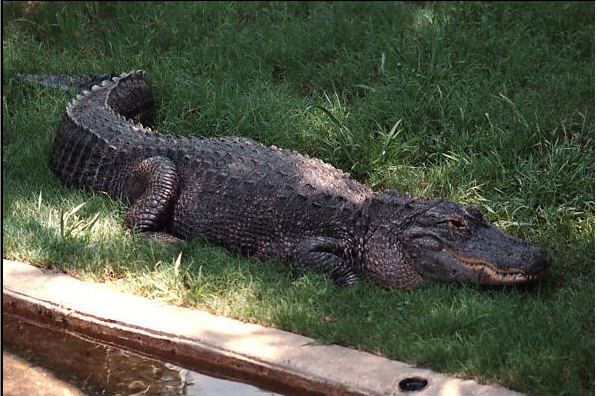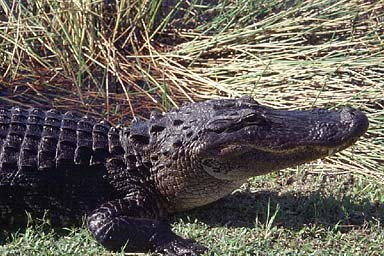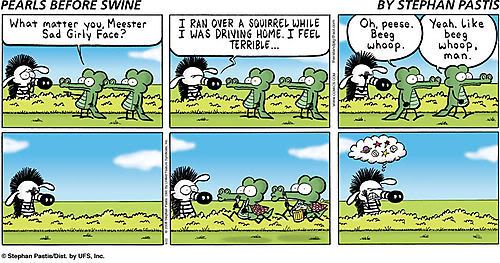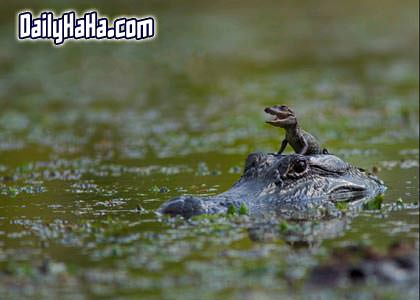 after the last Gator episode, but I just came across this USGS article and just could not wait to post it, sometimes truth is stranger
after the last Gator episode, but I just came across this USGS article and just could not wait to post it, sometimes truth is stranger  than fiction. And just what the heck does Gator Flavored Beer taste like!!!?? Please Please do not say chicken!!--JohnOh--
than fiction. And just what the heck does Gator Flavored Beer taste like!!!?? Please Please do not say chicken!!--JohnOh--

John Sullivan (ribbitphotography)
Alligator mississippiensis (Daudin, 1801)
Common Name: American Alligator
Synonyms and Other Names: gator, lagarto
Identification: Alligator mississippiensis is a robust crocodilian with a total length of 1.8-5 m (6-16.5 ft), and a record length of 5.84 m (19 ft 2 in) (Conant and Collins, 1998). American alligators can be distinguished from Crocodylus acutus, the American crocodile, and Caiman crocodilus, common caiman, by the presence of a broad, rounded snout, without conspicuous teeth protruding while the mouth is closed (especially the lower 4th tooth) (Behler and King, 1979; Conant and Collins, 1998; Powell et al., 1998). Unlike C. crocodilus, alligators lack a prominent bony ridge in front of and between the eyes (Behler and King, 1979; Conant and Collins, 1998; Powell et al., 1998). See the species accounts titled "Crocodylus acutus (Cuvier, 1807)" and "Caiman crocodilus (Linnaeus, 1758)" on this website for comparison. The general dorsal coloration is black, but light juvenile markings may be present in adults; young have bold, yellowish crossbands on a black background (Grenard, 1991; Conant and Collins, 1998). The voice of both males and females is a throaty, deep, bellowing roar (McIlhenny, 1935; Elliott, 1994; Conant and Collins, 1998). Elliott (1994) has made a recording of this penetrating roar available on a CD. Females may grunt like pigs when calling to their young (McIlhenny, 1935; Conant and Collins, 1998).

John Sullivan (ribbitphotography)
American alligators have been illustrated by numerous authors over the years; the list provided here is not exhaustive (Reese, 1912; McIlhenny, 1935; Neill, 1971; Guggisberg, 1972; Carr, 1973; Mount, 1975; Perrero, 1975; Smith and Smith, 1977; Behler and King, 1979; Toops, 1979; Martof et al., 1980; Smith and Brodie, 1982; Garrett and Barker, 1987; Webb et al., 1987; [Sievert] and Sievert, [1988]; Dundee and Rossman, 1989; Hirschhorn, 1989; Lazell, 1989; Ross, 1989; Ross and Magnusson, 1989; Ashton and Ashton, 1991; Carmichael and Williams, 1991; Glasgow, 1991; Grenard, 1991; Mahony, 1991; Ross and Ernst, 1994; Palmer and Braswell, 1995; Lamar, 1997; Conant and Collins, 1998; Magnusson, 1998; Powell et al., 1998; Bartlett and Bartlett, 1999a, b; Behler, 1999; Zug et al., 2001).
Size: total length of 1.8 - 5 m
Native Range: The indigenous range of A. mississippiensis is from coastal North Carolina south to southern Florida and the Keys, and westward through the Deep South to central Texas and extreme southeastern Oklahoma (Martof, 1956; Duellman and Schwartz, 1958; Webb, 1970; Mount, 1975; Stevenson, 1976; Martof et al., 1980; Lohoefener and Altig, 1983; Garrett and Barker, 1987; Groombridge, 1987; Moler, 1988; [Sievert] and Sievert, [1988]; Carpenter and Krupa, 1989; Dundee and Rossman, 1989; King, 1989, 2000; Lazell, 1989; Ross and Magnusson, 1989; Ashton and Ashton, 1991; Carmichael and Williams, 1991; Gibbons and Semlitsch, 1991; Grenard, 1991; Ross and Ernst, 1994; Palmer and Braswell, 1995; Conant and Collins, 1998; Bartlett and Bartlett, 1999a, b; Behler, 1999; Dixon, 2000; Meshaka et al., 2000). American alligators may eventually be found in Mexico in localities adjacent to the Texas border (Smith and Smith, 1976, 1977, 1993; Ross and Ernst, 1994). Over much of its range A. mississippiensis has been eliminated, making an accurate determination of its modern distribution difficult (Ross and Ernst, 1994; Conant and Collins, 1998).
Most of us know Gator is well traveled, but man, who knew to this extent. Our
 own lovable Mississippiensis has made it from east to west and north to south and beyond this great country. Might just explain some of the strange fauna that has been reported over the years in different places. --JohnOh--
own lovable Mississippiensis has made it from east to west and north to south and beyond this great country. Might just explain some of the strange fauna that has been reported over the years in different places. --JohnOh--
Arizona: In 1990, two A. mississippiensis were collected from the Papago Park Ponds, Phoenix, Maricopa County (M. Demlong, personal communication 1997).
California: In 1954, a 3 m A. mississippiensis was collected from the Colorado River in an unspecified county (Bury and Luckenbach, 1978). Rumors of nonindigenous crocodilians living in the waterways of California are common (Bury and Luckenbach, 1976). A single individual was captured in a back yard in Napa in 2005 (AP 2005). A single specimen is living in Lake Machado in Los Angeles county as of October, 2005 (Rane 2005).
Colorado: An A. mississippiensis was collected from the Boulder Country Club, Boulder, Boulder County in 1978 (Livo et al., 1998). In 1991, two American alligators escaped from a roadside zoo into the Colorado River near Fruita, Mesa County (Livo et al., 1998).
Indiana: Small alligators are frequently collected from various localities (not specified) in Indiana (Minton, 2001). In 2002, a 2 foot long alligator was collected in South Bend, Indiana by residents who spotted the creature by their side door (Beltz, 2002).
Missouri: An A. mississippiensis was collected from a pond off Sinks Road near the town of Ferguson, St. Louis County in 2003 (Bergman, 2003).
New York: Numerous records of nonindigenous A. mississippiensis exist for the state of New York (Mikkelson and Mikkelson, 2001). In Orange County, an A. mississippiensis was found in a stream in Middletown in 1927, and another on a residential lawn in Port Jervis 1929 (Mikkelson and Mikkelson, 2001). In Westchester County, an American alligator was found in bushes at an estate in Pleasantville in 1931, and two others, one in Northern Yonkers and another dead one near the Grassy Sprain Reservoir, in 1935 (Mikkelson and Mikkelson, 2001). A 4-ft, "exhausted" A. mississippiensis was collected from the East River, Suffolk County, by a barge captain in 1937 (Mikkelson and Mikkelson, 2001). In Kings County, an A. mississippiensis was collected from a trashcan at the Brooklyn Museum station in 1937 (Mikkelson and Mikkelson, 2001). In Westchester, Bronx County, five alligators were collected from Huguenot Lake in 1938, and another from the Kensico Reservoir in 1982 (Mikkelson and Mikkelson, 2001). In 1935 a 6-ft A. mississippiensis was collected while escaping from a sewer in New York City (Mikkelson and Mikkelson, 2001). This last report could be partially responsible for the urban myth of a population of alligators inhabiting New York City's sewage system; however, the tall tale told by T. May in Daley (1959) of a colony of American alligators living in the sewers beneath the city did much to promote this popular myth (Mikkelson and Mikkelson, 2001). A mississippiensis was captured in the town of Wayland, Steuben County, New York ( 10NBC email news 2003).
In 23 June 2001, a 4-ft A. mississippiensis was observed living in Scajaquada Creek, Buffalo, Erie County (Anonymous, 2001a, b; Beebe, 2001a, b). After pursuit and much publicity it was eventually collected from the creek on 27 June (Anderson and Habuda, 2001; Anonymous, 2001b; Beebe, 2001c; Heaton-Jones, 2001).
New Jersey: In Essex County, a hunt was organized to collect alligators seen in the Passaic River, Belleville, in 1933 (Mikkelson and Mikkelson, 2001). In Union County, an A. mississippiensis was collected from Lake Mindowaskin, Westfield, in 1942 (Mikkelson and Mikkelson, 2001).
North Carolina: Nonindigenous A. mississippiensis are known from the North Carolina counties of Camden, Gates, Harnett, Moore, Richmond, Scotland, and Wilson (Palmer and Braswell, 1995).

Oklahoma: Nonindigenous juvenile American alligators frequently show up as released pets throughout Oklahoma (Webb, 1970; [Sievert] and Sievert, [1988]). These sightings obfuscate the status and distribution of rare indigenous American alligators in the extreme southeastern corner of the state ([Sievert] and Sievert, [1988]).
Pennsylvania: In 2004, a A. mississippiensis was collected in the Alleheny River near the dam in Harmarville, Alleheny County. (Weisberg, 2004)
Texas: There has been speculation that the A. mississippiensis populations in the Brownsville area, Cameron County, and the lower Rio Grande Valley are actually the result of nonindigenous introductions made between 1907 and 1956 (Conant, 1977; Smith and Kohler, 1978; Conant and Collins, 1998).
Virginia: Nonindigenous A. mississippiensis have been collected from the counties of Accomack (Lucas Creek in Newport News) in 1974, Hampton (Hampton city) in 1982, Louisa (Lake Anna) in 1978, Stafford (Aquia Creek) in 1982, and Virginia Beach (Lake Smith) in 1969 (Mitchell, 1994).
West Virginia: An A. mississippiensis was collected in Raleigh County in 1928 (Green and Pauley, 1987). Prior to 1987, M. Seidel received reports of American alligators from Lincoln and Wayne Counties (Greene and Pauley, 1987).
 Means of Introduction: In most instances A. mississippiensis shows up in nonindigenous localities because they are escaped or deliberately released pets; these include animals introduced to New York (Mikkelson and Mikkelson, 2001), Union County, New Jersey (Mikkelson and Mikkelson, 2001), West Virginia (Green and Pauley, 1987), Virginia (Mitchell, 1994), Indiana (Minton, 2001), Oklahoma (Webb, 1970; [Sievert] and Sievert, [1988]), Boulder, Colorado (Livo et al., 1998), and probably Arizona and North Carolina.
Means of Introduction: In most instances A. mississippiensis shows up in nonindigenous localities because they are escaped or deliberately released pets; these include animals introduced to New York (Mikkelson and Mikkelson, 2001), Union County, New Jersey (Mikkelson and Mikkelson, 2001), West Virginia (Green and Pauley, 1987), Virginia (Mitchell, 1994), Indiana (Minton, 2001), Oklahoma (Webb, 1970; [Sievert] and Sievert, [1988]), Boulder, Colorado (Livo et al., 1998), and probably Arizona and North Carolina.
The alligators spotted in Essex County, New Jersey, may have escaped a lagoon in Military Park, Newark (Anonymous in Mikkelson and Mikkelson, 2001). Perhaps they had been part of a public animal display. The A. mississippiensis collected from Mesa County, Colorado, escaped from a roadside zoo (Livo et al., 1998), while the one collected from the Colorado River in California had been released (intentionally?) from a traveling carnival (Bury and Luckenbach, 1978).
Conant (1977) suggested that an animal dealer intentionally established the A. mississippiensis population found in the Brownsville area of Cameron County, Texas.
Status: All the American alligators found in New York have been collected (Anderson and Habuda, 2001; Anonymous, 2001a, b; Beebe, 2001c; Heaton-Jones, 2001; Mikkelson and Mikkelson, 2001). They are not established in this state nor could they survive the cold winters, and the story of alligators dwelling in New York City sewers is simply a well-entrenched myth (Mikkelson and Mikkelson, 2001).
One of the alligators found in Union County, New Jersey, was collected; although there is no further word about the success of the 1933 great gator hunt started on the Passaic River in Essex County (Mikkelson and Mikkelson, 2001).
All A. mississippiensis from Virginia, West Virginia, Indiana, and California were collected with no further evidence of established populations (Bury and Luckenbach, 1978; Green and Pauley, 1987; Mitchell, 1994; Minton, 2001).
Palmer and Braswell (1995) provide little detail of nonindigenous A. mississippiensis in North Carolina, but suggest some individuals are "thriving." There is no evidence of reproduction.
There is a possibility that introduced American alligators in Oklahoma may establish populations in or near the southeastern corner of the state; thus interacting with indigenous populations in this region ([Sievert] and Sievert, [1988]).
The A. mississippiensis populations in the Brownsville area, Cameron County, and the surrounding lower Rio Grande Valley are established but some authors suggest they could be nonindigenous (Conant, 1977; Conant and Collins, 1998). Since alligators were reported from the Brownsville region before the presumptive introductions took place (Baird, 1859), they are probably indigenous (Ross and Ernst, 1994). Indigenous populations may have simply been augmented by intentional introductions (Conant, 1977).
Always popular where ever he goes!! Sometimes VERY popular.
The A. mississippiensis in Boulder, Colorado, was collected (Livo et al., 1998). Only one of the American alligators was collected from the Colorado River, Mesa County, Colorado; the other was never recaptured, but there is no evidence of an established population (Livo et al., 1998).
The American alligators from Phoenix, Arizona, were collected (M. Demlong, personal communication 1997); however, Howland (1996) lists this species as "not well established" in Arizona.
Impact of Introduction: There is no evidence that any of the nonindigenous occurrences of American alligators have had any impact on indigenous ecosystems; however, an established population of these massive carnivores in a southwestern state could negatively impact indigenous fauna. The introductions in Oklahoma, and the presumptive introduction in Cameron County, Texas, could compromise the genetic integrity of extant indigenous populations. As mentioned above, the status of indigenous alligators in Oklahoma could be obfuscated, thus creating difficulties when deciding conservation measures and future protective legislation.
A large alligator is a potentially dangerous carnivore. While attacks on humans are exceedingly rare, they do occur on occasion (Pooley et al., 1989; Ashton and Ashton, 1991; Anonymous, 2002).
Remarks: The taxonomy of A. mississippiensis has been reviewed or summarized by Smith and Smith (1977), King (1989), Ross and Ernst (1994), and Crother et al. (2000). Liner (1994) provides a Spanish vernacular name for the American alligator. Brisbin et al. (1986), Gibbons and Semlitsch (1991), and Ross and Ernst (1994) provide the best literature reviews of the natural history of alligators. A variety of authors have contributed to or summarized the natural history and biology of American alligators (Reese, 1912; McIlhenny, 1935; Neill, 1971; Carr, 1973, 1976; Mount, 1975; Lang, 1987, 1989; Dundee and Rossman, 1989; Vliet, 1989; and a variety of contributions compiled by Webb et al., 1987).

Alligator mississippiensis is an aquatic, omnicarnivorous reptile capable of living in many types of waterways, both natural and man-made, and feeding upon almost any fauna it can catch (McIlhenny, 1935; Neill, 1971; Mount, 1975; Dundee and Rossman, 1989; Ashton and Ashton, 1991). Some alligators dig deep holes with connecting dens than can remain filled with water during droughts, thus maintaining an aquatic environment for indigenous fauna (McIlhenny, 1935; Neill, 1971; Carr, 1973; Dundee and Rossman, 1989; Grenard, 1991). Courtship and mating involves complex visual and auditory displays directed at prospective mates and competitors (McIlhenny, 1935; Lang, 1987, 1989; Vliet, 1989). The female buries her hard-shelled eggs in a nest she constructs of dead vegetation and the surrounding muck (McIlhenny, 1935; Dundee and Rossman, 1989; Ashton and Ashton, 1991). Females exhibit varying degrees of parental care by guarding the nest, releasing hatchlings from the nest and eggs, and transporting them to water in her mouth (Kushlan and Simon, 1981; Lang, 1987; Shine, 1988; Magnusson et al., 1989). Young may remain in a protective crèche with the mother and sometimes other adults for a considerable length of time, sometimes exceeding a year (Lang, 1987, 1989; Shine, 1988; Magnusson et al., 1989).

American alligators are subject to a variety of state and federal regulations (Levell, 1997); they should not be obtained by anyone before such legislation is understood along the responsibility that goes with keeping them as captives.
References
Author: Louis A. Somma
Revision Date: 6/30/2005
Citation for this information:
Louis A. Somma. 2009. Alligator mississippiensis. USGS Nonindigenous Aquatic Species Database, Gainesville, FL.
<http://nas.er.usgs.gov/queries/FactSheet.asp?speciesID=221> Revision Date: 6/30/2005



OMG~ this is to much...LMAOROF
ReplyDeleteCourtship and mating involves complex visual and auditory displays directed at prospective mates and competitors (McIlhenny, 1935; Lang, 1987, 1989; Vliet, 1989). ROFL, this is our Gator down to a tee lol. Very much into the visual and auditory isn't he. Very cool blog Pengy as usual!
ReplyDeleteLOLLLLLLLLLLL That sounds like our gator for sure.
ReplyDeleteAnddddd you just know that Gator is going to have to make a come back on you now lol !!!
ReplyDeleteLOL...gators cant take the cold eh? giggle..only in wisconsin pet stores...baby gators..oh my.
ReplyDeleteROFL... have to finish reading this on break tonight... awww but I will miss the music...
ReplyDeleteFrom what I've read thats our gator!!!! Have to love those Penguins and Gators!!!!
no crocagators in my part of the country lol
ReplyDeletewhere is the mississippiensis anyway?
haha the music is hysterical
ROFLOL My John..You really can come up with some interesting stuff. Sure am glad to see there is no mississippiensis in my state!
ReplyDeleteThought Id pop in a see what was up lol as always im Impressed. For thos that dont know the penguin is the keeper of the "Ancient Book of Gator Lore" and as you can see for a very good reason ..lmao and for those that think they are safe watch out we may be coming to a city near you
ReplyDeletethis is very educational. should print this out and make the students summarize this.
ReplyDeleteand yes, i concur, the gator is a fashion trend setter. ^&^
this is what the studious penguin looks like
ReplyDeletelol this is the sound of a happy or hopefully soon to be gator
ReplyDeletelol ok so i eat roadkill ..lmao some of us play with our food instead
ReplyDeleteROFLMBO!!!!!
ReplyDeleteSuddenly I feel rather warm and fuzzy all over. . .
ReplyDeleteThe American alligator known as Mississippi Alligator or Alligator mississippiensis belongs to the family Alligatoridae. The American alligator is one of the only two living species of alligator. The other one is the Chinese alligator or Alligator sinensis. The alligator word is derived from the Spanish 'el lagarto', which means lizard. According to scientific estimation, the American alligator is more than 150 million years old. It was the contemporary of the dinosaurs, which became extinct almost 65 million years ago.
ReplyDeleteyeah i am pretty old
ReplyDelete